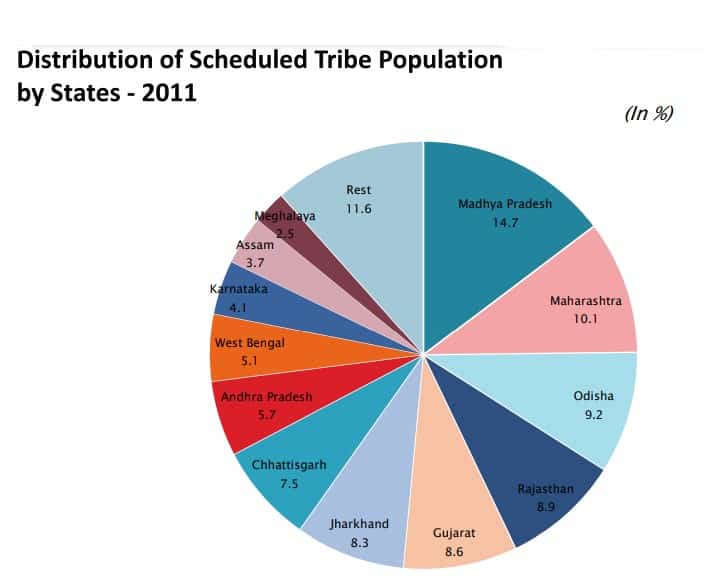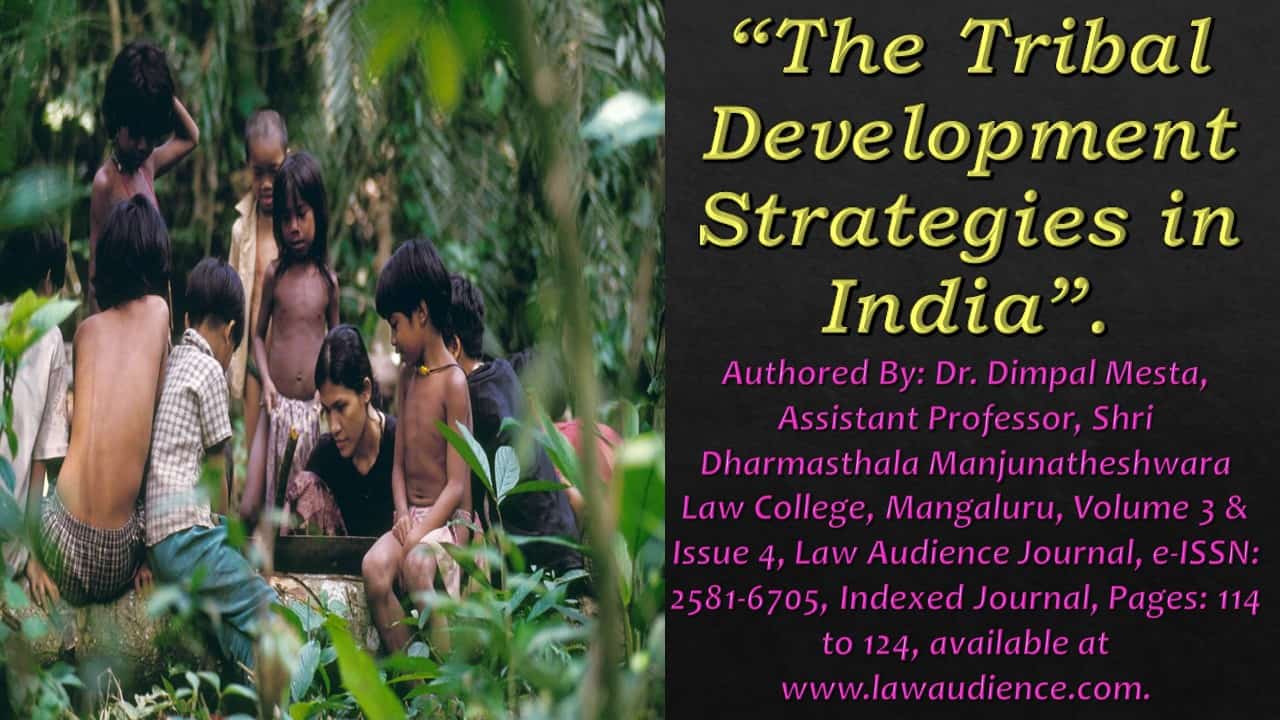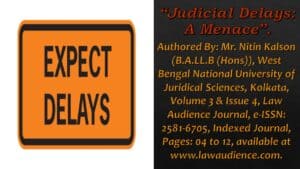Click here to download the full paper (PDF)
Authored By: Dr. Dimpal Mesta, Assistant Professor, Shri Dharmasthala Manjunatheshwara Law College, Mangaluru,
Click here for Copyright Policy.
ABSTRACT:
“India’s tribal belt refers to contiguous areas of settlement of Tribal people of India. The tribal population in India, though a numerically small minority, represents an enormous diversity of groups. They vary among themselves in respect of language and linguistic traits, ecological settings in which they live, physical features, size of the population, the extent of acculturation, dominant modes of making a livelihood, level of development and social stratification. While tribes have a distinct culture and history, they also share commonalities with other marginalised sections of Indian society, such as the lack of adequate political representation, economic deprivation and cultural discrimination. However, tribal society must be appreciated and it must be recognised that non-tribal people have much to learn from the richness of tribal cultures and systems of knowledge. Tribes are generally backward, economically as well as educationally. The situation is not uniform in all parts of India. The paper tries to understand the different aspects of Indian tribal life. The paper highlighted the major issues like problems, developmental mechanism etc.”
Keywords- Tribe, Problems, Development, Population.
I. INTRODUCTION:
Nowadays there is a movement world over protect the basic rights of the tribal people and almost all countries having such population have come out with necessary national laws for the protection of their rights and traits of life. The Draft National Policy on Tribals (2004) by the Union Government of India shows the concern of the government to protect the rights, lifestyle and customs of tribal people in India and ameliorate their position and bring in them in the mainstream of national life. The main aim of the law relating to tribal people is to protect their cultural identity and to strengthen them educationally and economically. Now various laws have been framed to protect tribal people, their style, their culture and their basic right to live in forests and use of forest produce.[1] The term ‘tribe’ has a Latin root. It has carried different connotations in different countries. For the Greeks the word meant fraternities, for the Romans it meant political divisions and the Irish history used the term to refer to communities having a common surname. However, in India, today, the term ‘tribe’ conveys a meaning of a bewildering and enchanting group of people who have been known by the various names from time immemorial. For ex-Vanvasi, Adivasi, Vanyajati and Adimyati.[2]
II. CHALLENGES FACED BY THE INDIAN TRIBALS:
During pre-independence era the tribal enjoyed unhindered rights of ownership and management over natural resources like land, forest, wildlife, water, soil, fish etc. with the advent of industrialization in India, these pockets were thrown open to outsiders and state control replaced tribal control. They are loss of control over natural resources, Lack of education, Displacement & rehabilitation, problems of health & nutrition gender issues and erosion of identity.[3] In Indian tribal society concern, the proportion and intensity of the problems are so serious. Each and every step of life there is a chain of problems. They are Naxalisem, Poverty, Health related issues, Land problems, educational problems, cultural & religious problems, women related issues, exploitation of children etc.[4]
As per the Census 2001, total population of the Scheduled Castes in the country (excluding the population of Mao Maram, Paomata and Purul sub-divisions of Senapati district of Manipur) is 166,635,700 which constitute 16.2% of the total population. Uttar Pradesh (35,148,377) has the largest Scheduled Caste population, followed by West Bengal (18,452,555) and Bihar (13,048,608). These states, along with Andhra Pradesh Tamil Nadu, Maharastra, Rajasthan, Madhya Pradesh, Karnataka and Punjab comprise the group of ‘top ten’ states in terms of large Scheduled Caste population in the country. In Nagaland, Lakshadweep, and A & N Islands, no Scheduled Caste is notified. Total population of Scheduled Tribes is 84,326,240 as per the Census 2001 which accounts for 8.2% of the total population of country. Majority of the Scheduled tribe population live in rural areas and their population is 10.4 % of the total rural population of the country.[5] According to 2011 census total population of Schedule Caste is 166,635,700 that is 16.2% of total population of India and Schedule tribes is 84, 326,240 that is 8.2% of total population of India.[6]

Source-Report of ministry of tribal affairs 2014.
III. TRIBAL DEVELOPMENT STRATEGIES:
Tribal development is important to achieve object of inclusive development.[7]An effective administrative mechanism/base needs to be instituted for local governance. This would ensure prompt delivery of services, greater professionalism and better management, technological adaptation, design and work process change, and complementary administrative reforms, among other things.[8]
III.I INTERNATIONAL LEGAL REGIME:
There has always been a movement to protect and preserve the identity and rights of tribal people. The term indigenous people have been used for such persons. The government of League of Nations also referred to non-self-governing or indigenous people and demanded their protection. After Second World War, various efforts have been made to recognize and implement the rights of tribal people. The International Commission on Environmental and Development in 1987 cautioned that tribal and indigenous people will need special attention as the forces of economic development disrupt their traditional life-style that can offer modern societies many lessons in the management of resources in complex forest, mountains and dry land ecosystem. The commission also recommended for the recognition of their traditional rights, to give them right to have a decisive voice in formulating policies about resource development in their area, and the protection of traditional rights should be accompanied by positive measures to enhance the well-being of the community in ways appropriate to the life-style of these group.[9]
III.II RIO DECLARATION:
The United Nations Conference on Environment and Development, held in Rio de Janeiro, Brazil, in June 1992, was an important development for indigenous peoples and their rights related to the environment. The Earth Summit, 1992 affirming the Stockholm Declaration of 1972, held at Rio-de-Janeiro. In Principle 22, the Declaration states that indigenous people and their communities and other local communities have a vital role in environmental management and development because of their knowledge and traditional practice. State should recognize and duly support their identity, culture and interests and enable their effective participation in the achievement of sustainable development.[10]
III.III THE CONVENTION ON BIOLOGICAL DIVERSITY, 1992:
It recognized the customary use of biological resources according to traditional cultural practices. It was also declared that traditional practices are relevant to the conservation of biological diversity and therefore, national legislation to respect, preserve the knowledge and practices of indigenous and local community must be passed (Article 8j). It was recognized by the convention that indigenous people are closely dependent on biological resources and have knowledge, innovations and practices relevant to conservation of biological diversity and the sustainable use of components. Now almost all the nations have ratified and adopted it.[11]
III.IV ILO RESOLUTION NO. 107 AND NO. 169:
Looking to the growing recognition of the rights of indigenous and tribal people, General Assembly of United Nations Organization (U.N.O) declared the year 1993 as the International Year for the World’s Indigenous People. Further the International Labour Organization in Resolution, 169 declared the rights of the indigenous and tribal people. It is also an international legal instrument on the subject. This resolution was the revision of International Labour Organization (ILO) Resolution 107 which was ratified by the Government of India too, in 1955.
This resolution advocated for the integration assimilation of its multicultural population into the mainstream of the national life. But the Government of India has not ratified Resolution No. 169.[12] According to Resolution No. 169 it has been declared that the distinctive cultural traditions of indigenous and tribal peoples must be protected by the national laws and place them on an equal footing in terms of their contribution to the making of the world’s culture. The resolution seeks to forge a partnership with indigenous people and communities and establish a process to empower them by adopting appropriate legislation or policies.
I.L.O Resolution 169 has declared various rights of indigenous people, such as:
(a) right of ownership and possession over the lands which they have traditionally occupied,
b) recognition and protection of their social, cultural religious and spiritual values and practices,
c) obligation of the government to consult with tribal people on all legislative or administrative measures affecting them and establish way for tribal people to participate in decision made by the government,
d) right of tribal people to decide the priorities for any development affecting them or their land,
e) rights of tribal people to their land’s natural resources, minerals, benefit of their exploitation and right to be compensated for damage,
f) guarantee to respect tribal people’s customs and laws etc.
India has taken necessary measures to recognize, protect and assimilate tribal people and has tried to translate ILO resolution 107 into action. The two most important laws about tribal peoples are Conventions 107 and 169 under the International Labour Organization (ILO) part of the UN system. These conventions oblige governments to identify the lands and protect these rights. It ensures recognition of tribal peoples cultural and social practices, obliges governments to consult with tribal peoples about laws affecting them, guarantees respect for tribal people’s customs and calls for protection of their natural resources.[13]
III.V NATIONAL COMMISSION ON THE WORKING OF CONSTITUTION, 2002 (CONSTITUTIONAL REVIEW COMMITTEE):
The commission, headed by Justice J.S.Verma, submitted its report on March 31, 2002, reviewed various provisions of the Constitution relating to protection and preservation of the tribal people. In its recommendations, it has proposed that- ‘Social safeguards should be provided to protect the wholesome traditions of the cultural heritage and of the intellectual property rights of the tribal people. The report also acknowledges that, the tribal communities are repositories of my ride cultural traditions-tribal lore, the arts and crafts, music, dance and design, textiles, metallurgy and eco-friendly technology. There is a tremendous range of attainment in all these different aspects of their heritage. Knowledge of flora and fauna, herbal medicine and therapies, time reckoning, animal husbandry, veterinary practices etc. represent additional areas of specialized knowledge in tribal societies in different parts of country. It is of crucial importance that these variegated elements of tribal cultural heritage are protected from overrun or expropriated.[14]
Some of the significant recommendations of the commission are as follows:
- strong legal action should be taken to prevent alienation of lands belonging to the Tribal Communities and effective prior rehabilitation of tribals before displacement due to development projects.
- Tribal communities must be associated with the management of forest resources, for not only their livelihood, but also be linked to forests.
- The tribal communities have to be associated with the management of forest resources, for not only their livelihood, but also for protecting their ways of life and culture identity which are indissolubly linked to forests.
- as a means of improving the administration of areas inhabited by scheduled Tribes and promoting local authority, all areas governed by the Fifth Schedule must be transferred to Sixth Schedule extending the applicability of the Sixth Schedule to tribal areas other than North Eastern States.
- The reports of the working groups for the Development of Scheduled Tribes, Scheduled Caste and Backward Classes and National Commission for Backward Classes should be implemented.[15]
III.VI INTERNATIONAL HUMAN RIGHTS AND PROTECTION OF INDIGENOUS PEOPLE AND THEIR ENVIRONMENT:
Local communities may claim protection for their traditional knowledge and resources on the basis of human rights law. Human rights protection includes the right to information, consultation and participation in decision making on proposals that affect local communities. The right to property is one of the strongest human rights claims for protection of indigenous people and their environment.[16]
III.VII PANCHAYAT (EXTENSION TO SCHEDULED AREAS) ACT, 1996:
The separate systems were approved by the Constituent Assembly formed at the time of independence after receiving recommendations that the distinct community structures and attitudes of the tribes in the two regions could not be treated in a common law. Though an overwhelming majority of India’s tribal people inhabit the fifth schedule areas, they were only recently introduced to decentralization when the Indian Parliament legislated the Panchayat (Extension to Scheduled Areas) Act, 1996 (or PESA) exclusively for these areas. PESA mandated the states to devolve certain political, administrative and fiscal powers to local governments elected by the communities (whether tribal or non-tribal). PESA did not amend the Fifth Schedule, however. Instead, it sought to secure the participation of the tribal communities through limited self-government, expecting this arrangement to be better suited to their ‘level of advancement’. After a decade, it is apparent that PESA is clearly not achieving that objective.
III.VIII TRIBAL SUB-PLAN (TSP):
In order to address tribal communities’ development challenges, the ‘Tribal Sub Plan strategy was developed by an Expert Committee set up by the Ministry of Education and Social Welfare in 1972 under the Chairmanship of Prof. S. C. Dube.’ This was adopted for the first time in the Fifth ‘Five Year Plan’, and started in fiscal year 1974-75. According to the revised guidelines of the Planning Commission (Govt. of India), issued on 31 October 2005, the broad objectives of the TSP are: Substantial reduction in poverty and unemployment, Creation of productive assets in favour of Scheduled Tribes to sustain the growth likely to accrue through development efforts, Human resource development of the Scheduled Tribes by providing adequate educational and health services, and Provision of physical and financial security against all types of exploitation and oppression, The funds for TSP are sourced through the following instrumentalities: (i) State Plans; (ii) Funds under TSP components of Centrally Sponsored Schemes (CSS) administered by Central Ministries/ Departments; (iii) Special Central Assistance to Tribal Sub-Plan (SCA to TSP), Grant under Article 275 (1) of the Constitution and other schemes implemented by Ministry of Tribal Affairs; (iv) Institutional Finance; and (v) Corporate Social Responsibilities (CSR) of Corporate Entities.[17]
The Tribal Sub-Plan for the Scheduled Tribes was designed to channelize the flow of outlays and benefits from the general sectors in the plans of the States and Union Territories (UTs) and Central Ministries in proportion to their population both in physical and financial terms. It is an umbrella under which all schemes implemented by the States and Central Governments are dovetailed for addressing different needs of the Scheduled Tribes. It is basically an area development programme with focus on tribals under which infrastructural development and family-oriented programmes are undertaken. The strategy has been successful in garnering larger flow of funds for the development of Scheduled Tribes. The Ministry of Tribal Affairs, besides providing Special Central Assistance, which is an additive to the Tribal Sub Plan of the States and UTs and grants under Article 275 (1) of the Constitution for raising the level of infrastructure in the Scheduled Areas and economic development of the Scheduled Tribes to the level of general population, is also implementing various Centrally-sponsored and Central sector schemes under which financial assistance ranging from 50 per cent to 100 per cent is given to the States and UTs for construction of hostels and coaching of ST students for competitive examinations, upgradation of their merit, research and training, setting up of ashram schools, vocational training centres, village grain banks, educational complexes for ST girls in low literacy pockets and development of primitive tribal groups. Besides, non-governmental organisations (NGOs) have also been involved in the development of STs. Their developmental and financial needs are being taken care of over and above the credit available through priority sector lending of banks and other institutions by the National Scheduled Castes Finance and Development Corporation (NSFDC). The Tribal Sub-Plan (TSP) strategy was initiated for the rapid socio-economic development of tribal people in the 5th Five-year Plan. The strategy for the TSP was prepared for areas of tribal concentration which were designated as Integrated Tribal Development Projects.
TSP is part of an overall plan of a State/ UT and has the objectives of socio-economic development and Protection of STs against exploitation through legal and administrative support for narrowing the gap between their levels of development to that of the general communities. Over the years, changes have been made in modalities to make the approach more effective and beneficial to the tribals.[18] Multi-pronged strategy for overall development of tribal people. Government has adopted a multi-pronged strategy for overall development of tribal people across the country, which includes support for education, health, sanitation, water supply, skill development, livelihood etc. Major part of infrastructure development and provision of basic amenities in tribal areas/regions in the country is carried out through various schemes/programmes of concerned Central Ministries and the State Governments concerned including North Eastern States, while the Ministry of Tribal Affairs provides additive to these initiatives by way of plugging critical gaps.
The details of important existing schemes of the Ministry are:
- Scheme of Girls & Boys Hostels for STs, Scheme of Ashram Schools in Tribal Areas,
- Scheme ofVocational Training in Tribal Areas,
- Grants-in-Aid to Voluntary Organisations working for the Welfare of Scheduled Tribes, Scheme for Strengthening Education among ST Girls in Low Literacy Districts,
- Pre-Matric Scholarship, Post Matric Scholarship,
- National Overseas Scholarship,
- Scholarship for Top Class Education and Rajiv Gandhi National Fellowship for ST students, Special Central Assistance to Tribal Sub Scheme (SCA to TSS) (hitherto known as SCA to Tribal Sub Plan (TSP),
- Grants under Article 275(1) of the Constitution, Development of Particularly Vulnerable Tribal Groups (PVTGs),
- Institutional Support for Marketing and Development of Tribal Products/Produce,
- Scheme of “Mechanism for Marketing of Minor Forest Produce (MFP) through Minimum Support Price (MSP) and Development of Value Chain for MFP,
- Tribal Research Institute (TRI).[19]
IV. CONCLUSION:
Tribals are among the most deprived sections of India. most of the Adivasi people do not have land. India has several laws and constitutional provisions, The laws aimed at protecting indigenous peoples have, however, numerous shortcomings and their implementation is far from satisfactory.
After discussing about various challenges and problems faced by the tribal people of India we can still hope for the better development because we have various legislations such as The Scheduled Tribes and other Traditional Forest Dwellers (Recognition of Forest Rights) Act, 2006, and even Constitutional provisions which favours the welfare and development of these indigenous populations. As we discussed above government has enacted various development schemes for tribal development scheme for tribal development.
Cite this article as:
Dr. Dimpal Mesta, “The Tribal Development Strategies in India”, Vol.3 & Issue 4, Law Audience Journal (e-ISSN: 2581-6705), Pages 114 to 124 (10th March 2022), available at https://www.lawaudience.com/the-tribal-development-strategies-in-india/.
Footnotes & References:
[1] Prof. Satish Shastri, Law relating to preservation and protection of the rights of tribal people n India, Journal of legal studies, Vol-xxxvi, 2005-06, p.3.
[2] Nitisha, Tribal Development in India, (yourarticlelibrary.com).
[3] Dr. Sinha, Six Main Problems Faced by the Indian Tribes. (yourarticlelibrary.com).
[4] Dr.Swati Girase, “The problem of Indian Tribal Communities in Current Scenario”, International Journal of Development Research, Vol.6, Issue 05, May 2016, p.7924.
[5] Census of India, 2001.
[6] Census of India 2011, Office of the Registrar General & census Commissioner, India. Ministry of Home Affairs, Government of India.
[7] Vice President of India, Shri M. Venkaiah Naidu, Inaugurates ‘Aadi Mahotsav’ a Mega National Tribal Festival, 16-November-2017.
[8] Report of Constitution, Human development in India: Emerging issues and policy perspectives, Feb-5,6 2010, New Delhi.
[9] http://en.wikipedia.org/wiki/International_regime.
[10] www.ohchr.org/Documents/Publications/GuideIPleafet10en.PDF.
[11] Amal Kumar Das, “Tribal Development and Environment, Socio-economic development in India”, Vol.2, Mohit Publications, New Delhi. p.515.
[12] Bennett, Gordon. “The I.L.O. Convention on Indigenous and Tribal Populations – The Resolution of a Problem of Vires.” British Yearbook of International Law, (1972-1973), 382.
[13] Virginius Xaxa, “Tribes as Indigenous People of India”, Economic & Political Weekly, December 18, 1999. P. 3590.
[14] Kanksha Mishra, “Tribal Laws in India and Tribal Conventions on Right of Indigenous People Worldwide”, Legal Articles, February 28, 2012.
[15] Ibid.
[16] Anupam Goyal, “The WTO and International environmental law towards conciliation”, Oxford University Press, New Delhi, 2006, p.280.
[17] Gladson Dungbung, “The Need for a New Approach to Adivasi Development”, 23 March, 2015 in Countercurrents.com.
[18] Research Study on Livelihood Options Assets Creation out of Special Component Plan (SCP) and Tribal Sub Plan (TSP) Scheme and Its Impact among SC and STs In India, Socio Economic and Educational Development Society (SEEDS) Planning Commission Government of India.
[19] Press Information Bureau Govt. of India Ministry of Tribal Affairs, 19th March 2018.




